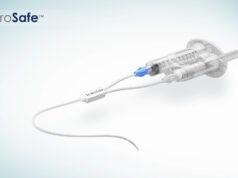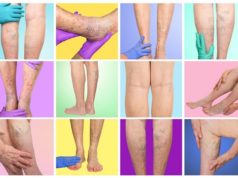
The first full results of the Early Venous Reflux Ablation (EVRA) ulcer study were presented at the Charing Cross Symposium (CX; 24-27 April, London, UK). The presentation was accompanied by simultaneous publication in the New England Journal of Medicine after the session.
The randomised trial revealed that early endovenous ablation outperforms deferred treatment in healing leg ulcers. It shows early ablation of superficial venous reflux results in faster healing of venous leg ulcers and patients having much more time free from ulcers than deferred ablation does. Early treatment is also cost-effective, which means that the findings of this trial, which provide the first high-quality data backing early ablation, will have global implications for clinical practice and patient care pathways. Nearly 90% of the CX voters agreed with the motion that the EVRA trial will change clinical practice.
“This presentation continues the great tradition of trials to come out from Imperial College at the Charing Cross Symposium,” said chief investigator of the trial, Alun Davies, Imperial College London, UK, who presented the clinical results along with the team at the Late breaking trials sessions yesterday. The EVRA ulcer study was funded by the National Institute for Health Research Health Technology Assessment Programme.
The ESCHAR trial previously showed that surgical correction of superficial venous reflux in addition to compression bandaging does not improve ulcer healing but reduces the recurrence of ulcers at four years and results in a greater proportion of ulcer free time. While compression bandaging is the mainstay of leg ulcer treatment, early intervention has long been taboo in certain circles. EVRA was designed to capture data on the timing of intervention.
EVRA set out to evaluate whether early endovenous ablation can improve venous ulcer healing in addition to compression therapy. The triallists including Manj Gohel (Cambridge, UK), reported the rationale and study methods; Francine Heatley (London, UK) provided data on the recruitment and demographics; and David Epstein (Granada, Spain) reported on the health ecoomics analysis of the trial.
The investigators reported in the NEJM that venous disease is the most common cause of leg ulceration. “Although compression therapy improves venous ulcer healing, it does not treat the underlying causes of venous hypertension. Treatment of superficial venous reflux has been shown to reduce the rate of ulcer recurrence, but the effect of early endovenous ablation of superficial venous reflux on healing remains unclear,” they write.
“The usual journey for a patient who presents with a leg ulcer is that they may be seen in primary care, or a wound health care centre. Often, they do not get referred on to a vascular specialist for evaluation to see if their veins can be treated. One of the mainstays of treatment is just use of compression therapy,” Davies noted.
Investigators working in 20 centres in the UK randomly assigned 450 patients with venous leg ulcers and superficial venous reflux to either an ‘early’ group that received compression therapy (with stockings or bandages) followed by endovenous ablation within two weeks (224) patients), or a ‘deferred’ group that received compression therapy followed by deferred ablation i.e. after the leg ulcer had healed, “which often in the UK is regarded as standard practice,” said Davies. The latter group consisted of 226 patients. Of these, 31 patients were lost to follow-up, or withdrew and 12 died leaving 387 patients in the per protocol analysis.
The primary outcome measure was the time to ulcer healing from the date of randomisation. The secondary outcome measures were the rate of ulcer healing at 24 weeks; the length of time free from ulcers (ulcer-free time) during the first year after randomisation; and patient-reported health-related quality of life as measured by Venous Clinical Severity Score (VCSS), Quality of life (AVVQ, EQ-5D-5L, SF36) and cost-effectiveness.
In the trial, treatment modality and strategy was determined by the treating clinical team. Endovenous ablation included the use of foam, endothermal ablation and non-thermal techniques. “The outcomes of all modalities are good, and we are not going to break down the data by technique,” Davies commented.
With a sample size of 450 patients (or 254 leg ulcer healing events), the study was powered to detect 15% difference in 24-week healing rate (60% vs.75%) with 90% power and 5% significance.
Results
Patient and clinical characteristics at baseline were similar in the two treatment groups. The time to ulcer healing was shorter in the early intervention group than in the deferred intervention group; more patients had healed ulcers with early intervention (hazard ratio for ulcer healing, 1.38; 95% confidence interval, 1.13 to 1.168; p=0.001). The median time to ulcer healing was 56 days (95% CI, 49 to 66) in the early intervention group and 82 days (95% CI, 69 to 92) in the deferred-intervention group. The hazard ratio for ulcer free time in the early group was 1.54 (95% CI, 1.07–2.21) p=0.02. At both six weeks and six months, the group that received early intervention had significantly better quality of life scores. With regard to procedure complications, there were more instances of deep vein thrombosis in the group receiving early intervention, than in the group receiving delayed intervention.
“EVRA is the first large randomised trial to confirm that early endovenous ablation accelerates ulcer healing. In the UK, and worldwide, it is important to look at whether a treatment is cost-effective. We found the pathway of early intervention was undoubtedly cost-effective. The results revealed an 86–99% probability that early intervention is cost-effective at the UK National Institute for Health and Care Excellence (NICE) threshold,” explained Davies.
Ramifications
“These data highlight the need for a major review of leg ulcer care pathways worldwide so that we can implement a strategy for rapid assessment and ablation of superficial venous reflux for patients with venous leg ulcers. Education of patients, nursing teams, healthcare professionals and commissioners is essential,” Davies stated at the first CX Press Conference.
At the Charing Cross Symposium, Raghu Kolluri, Columbus, USA, commented on the ramifications of the trial to say: “EVRA showed faster ulcer healing, more ulcer free days and cost savings. Several recommendations such as the current Society for Vascular Surgery (SVS)/American Venous Forum (AVF) guidelines are based on evidence at the level of 2C, and we hope that this will change to incorporate EVRA into the treatment algorithm. It is also important to educate all involved in venous leg ulcer care.”
Davies reiterated the point, “We will undoubtedly need to see a rewrite of many of the international the global guidelines but one of the key things is to empower the nurses and people with leg ulcers to actually seek referral to a vascular specialist and to persuade the insurers globally, and commissioners in the UK i.e., those who monitor and dispense healthcare budget that endovenous ablation is a very cost-effective way to treat patients. In the UK, we hope to see patients, rather than languishing in the community, being referred for very early evaluation and early intervention. As you can see from the data, we were unable to randomise over a third of patients because they had their leg ulcer present for more than six months, and there is a large group of people who have chronic leg ulcers who never really get assessed for intervention. Education of patients and those with first contact with patients for referral to a specialist who can carry out the appropriate evaluation and treatment is vital.”












